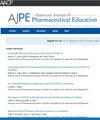药学院教师对导致首次 NAPLEX 考试通过率下降的因素的看法。
IF 3.5
4区 教育学
Q1 EDUCATION, SCIENTIFIC DISCIPLINES
引用次数: 0
摘要
目标:确定整个学院的药剂学教师对可能影响 NAPLEX 首次通过率的因素的看法:确定整个学院的药学教师对可能影响 NAPLEX 首次通过率的因素的看法,以突出基于共同经验的进一步研究的潜在重点领域:向美国药学院协会的教职员工发放了一份包含 43 个项目的 Qualtrics™ 匿名问卷。问题主要是 5 点李克特量表项目(5=影响非常大),包括六个方面:药学院因素、COVID-19 教育调整、考试因素、标准化考试、申请人准备情况和学生因素。结果显示,共分析了 600 份问卷:共分析了 600 份回复。受访者主要为女性(66%)和白人(78%)。大多数人拥有药学博士学位,接受过住院医师培训,并且是美国南部和中西部地区的执业药剂师。受访者表示,NAPLEX 首次通过率下降是一个中度到严重的问题(平均值 3.64,标准差 [SD] 0.891),潜在的首要影响因素包括学生素质(平均值 3.99,标准差 0.876)、学生的批判性思维(平均值 3.90,标准差 0.947)、学习习惯(平均值 3.74,标准差 0.920)和录取标准(平均值 3.67,标准差 1.082):受访者认为影响 NAPLEX 首次通过率的前 4 个因素都与学生素质有关。这一结果凸显了探讨药学录取相关问题的重要性,以及实施有效策略以支持越来越多准备不足的药学学生的必要性。本文章由计算机程序翻译,如有差异,请以英文原文为准。
Perceptions of Pharmacy Educators Regarding the NAPLEX Pass Rate Puzzle
Objective
Identify perceptions from pharmacy faculty across the Academy concerning factors that may be influencing North American Pharmacist Licensure Examination (NAPLEX) first-time pass rates to highlight potential focused areas of further research based on common experiences.
Methods
An anonymous 43-item Qualtrics questionnaire was distributed to faculty members from the American Association of Colleges of Pharmacy. Questions were predominantly 5-point Likert scale items (5 = very large impact) and encompassed 6 domains: pharmacy school factors, COVID-19 educational modifications, testing factors, standardized testing, applicant preparedness, and student factors. Demographic data and perceptions were reported with means and standard deviations (SD).
Results
In total, 600 responses were analyzed. Respondents were predominantly female (66%) and white (78%). Most had a Doctor of Pharmacy degree and residency training and were practicing as a licensed pharmacist within the southern and midwestern United States. Respondents indicated that the decline in NAPLEX first-time pass rates is a moderate to large problem (mean 3.64, SD 0.891), and the top potential influencing factors include student quality (mean 3.99, SD 0.876), student’s critical thinking (mean 3.90, SD 0.947), study habits (mean 3.74, SD 0.920), and admission standards (mean 3.67, SD 1.082).
Conclusion
The top four factors indicated by respondents as impacting the NAPLEX first-time pass rates were related to the student quality. This result highlights the importance of exploring issues related to pharmacy admissions and the need to implement effective strategies to support an increasing number of potentially less prepared pharmacy students.
求助全文
通过发布文献求助,成功后即可免费获取论文全文。
去求助
来源期刊
CiteScore
4.30
自引率
15.20%
发文量
114
期刊介绍:
The Journal accepts unsolicited manuscripts that have not been published and are not under consideration for publication elsewhere. The Journal only considers material related to pharmaceutical education for publication. Authors must prepare manuscripts to conform to the Journal style (Author Instructions). All manuscripts are subject to peer review and approval by the editor prior to acceptance for publication. Reviewers are assigned by the editor with the advice of the editorial board as needed. Manuscripts are submitted and processed online (Submit a Manuscript) using Editorial Manager, an online manuscript tracking system that facilitates communication between the editorial office, editor, associate editors, reviewers, and authors.
After a manuscript is accepted, it is scheduled for publication in an upcoming issue of the Journal. All manuscripts are formatted and copyedited, and returned to the author for review and approval of the changes. Approximately 2 weeks prior to publication, the author receives an electronic proof of the article for final review and approval. Authors are not assessed page charges for publication.

 求助内容:
求助内容: 应助结果提醒方式:
应助结果提醒方式:


